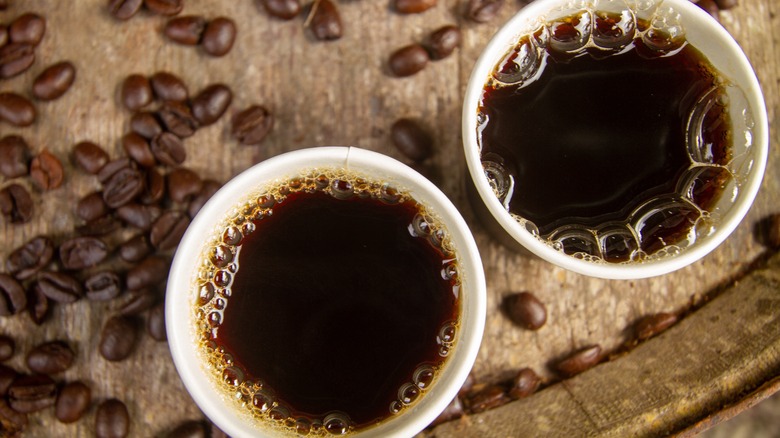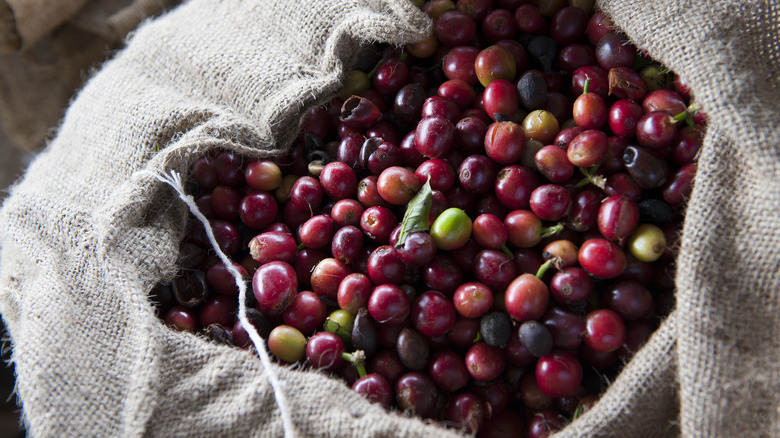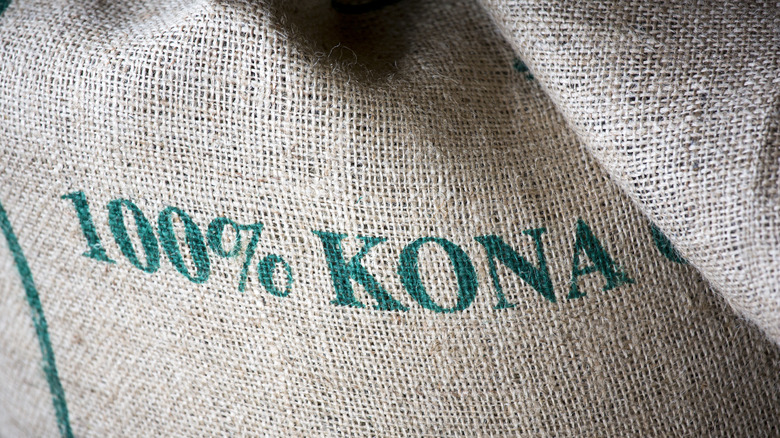What Makes Kona Coffee So Expensive?
Kona coffee, by definition, is exclusively sourced from beans grown in the Kona Coffee Belt on Hawaii (aka the U.S. state's biggest island, not the island chain in its entirety). At least that's the case if the bag you've bought reads 100% Kona Coffee.
These coffees have a reputation for quality, and for being expensive. But the two aren't necessarily linked. Unroasted Kona Coffee doesn't sell for up to $50 a pound because it's excellent, but rather because of the labor involved in its harvesting. Unlike most coffees, which are picked mechanically, Kona coffee beans are picked selectively by hand. This is due to elevation and uneven growing conditions in the Kona Coffee Belt — where farms are typically located between 800 and 2,500 feet high across the slopes of two volcanoes (Mauna Loa and Hualalai).
Rarity is also a factor in the pricing, as is the cost of labor and production. It's been judged, for example (via Big Island Coffee Roasters), that about 40% of the cost consumers pay for the coffee is attributable to the fact that it's harvested by hand. Of course, it bears noting that not all Kona coffees are authentic. Forgeries abound, as do blends that feature no more than 10% Kona-sourced beans.
The high cost of making Kona coffee
It's not just that Kona coffee has to be hand-picked, but that it's selectively hand-picked by workers who make a fair living wage. The current minimum wage in Brazil, for example — the world's leading coffee producer – is only about $283 per month. The current minimum wage in Hawaii is $14 per hour, and that rate is expected to rise to $18 per hour within the next four years.
Selective picking, too, is important to many of the qualities evident when coffee tasting, but also in how labor-intensive Kona is to produce. This term indicates that the beans weren't merely picked by hand, but done so at the peak of ripeness, a process that requires workers to return on multiple occasions. It's a far cry from the mechanized method in which beans are shaken loose simultaneously regardless of individual ripeness levels, but also superior to the standard 'strip picking' method used by many farms that harvest by hand where all beans are gathered, regardless of ripeness. By using selective picking techniques, Kona growers are ensuring the highest level of specialty coffee, typically with a more complex flavor profile than the alternatives.
But it's expensive, and so is the land on which the beans are located. Hawaii ranks highly among U.S. states in terms of the value of an average acre of land. Transportation costs to ship the coffee from Hawaii to the mainland are another contributing factor to its expensive price tag.
How to ensure you're buying authentic Kona coffeee
There are now about 1,000 farms harvesting beans in the Kona Coffee Belt, which is a thin band of elevated land roughly 30 miles in length, but only a mile or two in width. Compare this to Brazil, where nearly 5,000,000 acres are dedicated to coffee production, and it highlights the fact that Kona is a rare type of coffee, both in terms of its quality and its production.
Despite this relatively modest growing area, almost three million pounds (2.7 million, to be exact) of Kona coffee are produced annually. The problem, both for consumers and for reputable distributors, is that more than 20 million pounds of coffee bear the Kona label (per Daily Coffee News). This disparity is accounted for both by counterfeits and by blends featuring a small percentage of Kona but with the lion's share of the coffee in each bag produced in other countries.
Hawaiian lawmakers are currently debating stricter labeling requirements that would up the minimum 10% currently required to use the name Kona, reports Maui Now. In the meantime, consumers looking to get their hands on the real McCoy should seek out bags with labels that advertise 100% Kona coffee. Even with this promise, however, it's important to buy only from trusted Hawaiian roasters to avoid falling prey to counterfeits. Price is another good indicator of authenticity. If it's not expensive, it's probably not Kona.



